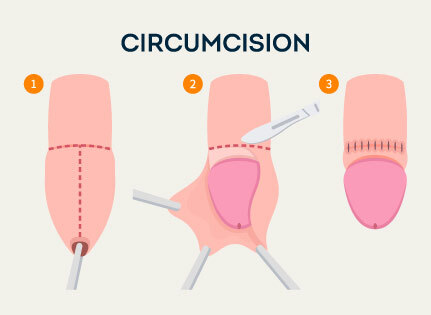Circumcision in adults
Circumcision is more associated with adults than in infants. Patients who undergo circumcision usually do it for religious or medical reasons. Here is what you can expect during the surgery –
- During the procedure – The anesthesiologists administer anesthesia before the surgery to sedate your surgical site for a painless experience. The procedure can take anywhere between 30 minutes to 1 hour, depending on the surgical expertise of the urologists and the medical health of the patient. The doctor clips the foreskin away from the tip of the penis and removes the excess skin. The skin is then cauterized or stitched back to the shaft with sutures that eventually dissolve. You can go home on the same day of the surgery if your doctor sees you fit.
- After the surgery – You’re likely to experience swelling and bruising during the initial hours after the surgery. Applying ice to your groin for 10 to 20 minutes after every two hours can help reduce pain after the surgery. It is also important to change your dressing frequently, as suggested by your medical practitioner, to keep your penis clean and prevent infection. Since recovery may take around 2 weeks, depending on the health condition of the patient, you may have to take a week off from work.
Circumcision in children
Circumcision in infants can be performed on the second or third day after the birth. Some people prefer circumcising their children during later stages in life due to social, religious, or medical purposes. It is important to consult a physician regarding your child’s health before their circumcision procedure. If you are considering circumcision for your child, here are some things you should know-
- Preparing your baby for the procedure – First, consult the doctor regarding your baby’s health and all the risks and complications involved during the procedure. In some cases, when the baby is born premature, involving problems related to penile health, etc., parents can delay the procedure. Your medical practitioner will explain all the possible risks and complications related to the surgery, and after you have signed the consent form, the doctor will begin the procedure.
- During the procedure – If the circumcision is done for the newborn, they’ll be awake during the procedure. Once the procedure is done, the doctor will inject an anesthetic near the base of the penis to ease the pain. Doctors may choose to apply cream reliever ointment as an alternative to anesthetic injection. The surgeon inserts clamps or plastic rings to clip off the excess foreskin. The ring that stays on usually falls off a few days after the circumcision. The surgery usually takes around 10 minutes, and you can leave with your baby a few hours after the procedure after consulting the doctor.
- After the procedure – The procedure may make your kid fussy and irritable and so it is not advisable to put pressure on their penis. The tip of the penis may appear red and swollen, along with a yellow crust on the tip as well. This should go away on its own within 7 to 10 days after the procedure. You can gently wash the penis and regularly change the bandages while changing their diapers. You can use lubrication to keep the penis from sticking to the diaper. Changing diapers regularly can help ward off infection.
Benefits of Laser circumcision
Laser circumcision – Laser circumcision is an advanced method used as an alternative for traditional circumcision procedures. This involves the removal of the foreskin of the penis surgically for religious or medical purposes. It involves a laser or a powerful light beam to remove the foreskin around the tip of the penis. Surgeons with laser circumcision are able to achieve high precision, making it a more preferred surgical method today. Laser circumcision involves faster recovery and fewer chances of complications.
Benefits of laser circumcision include the following-
- Reduced risk of infection
- Minimal scars
- Almost no side effects
- Faster recovery
- Shorter hospital stay
- Minimal blood loss
- Painless procedure
- Higher success rate








.svg)









